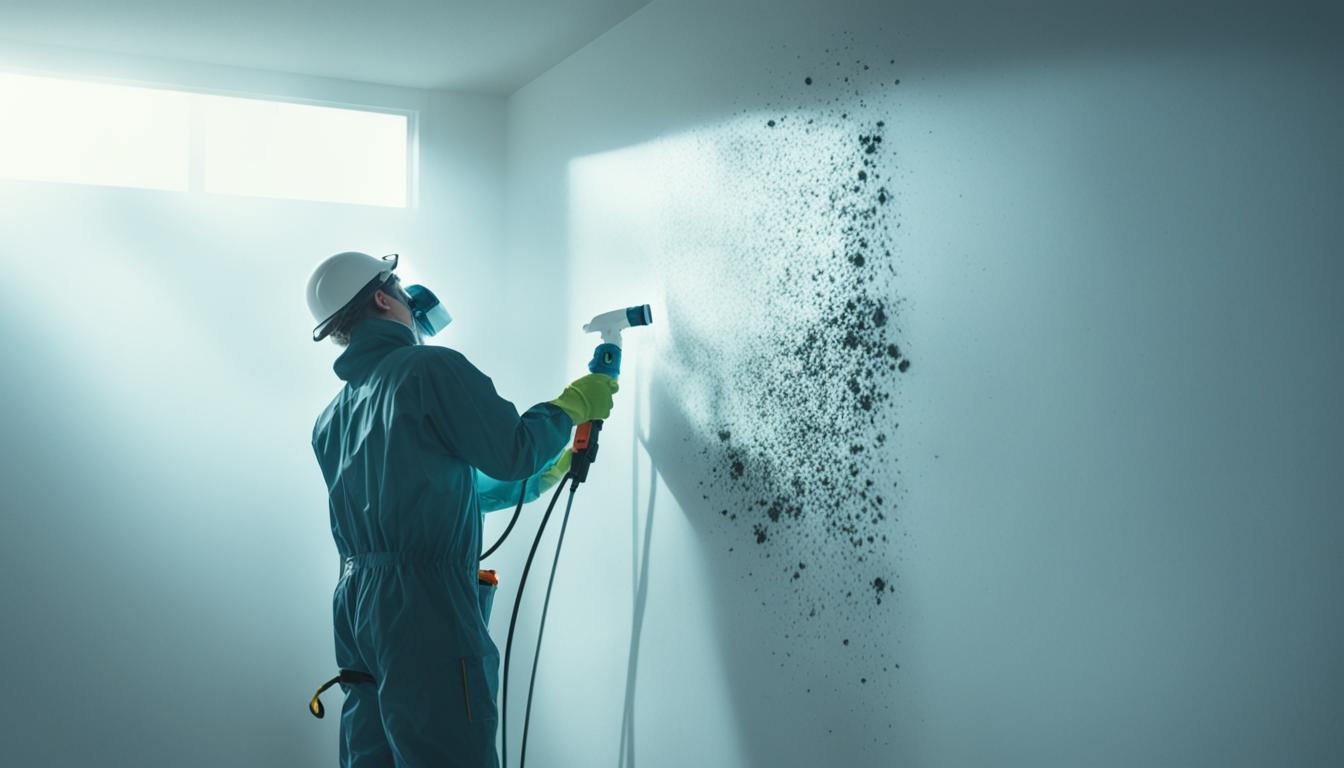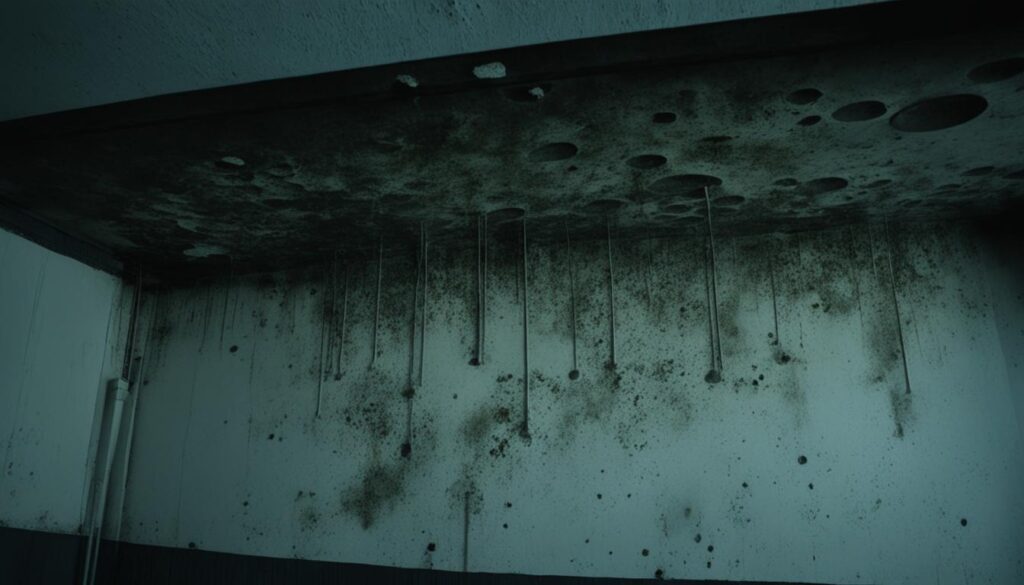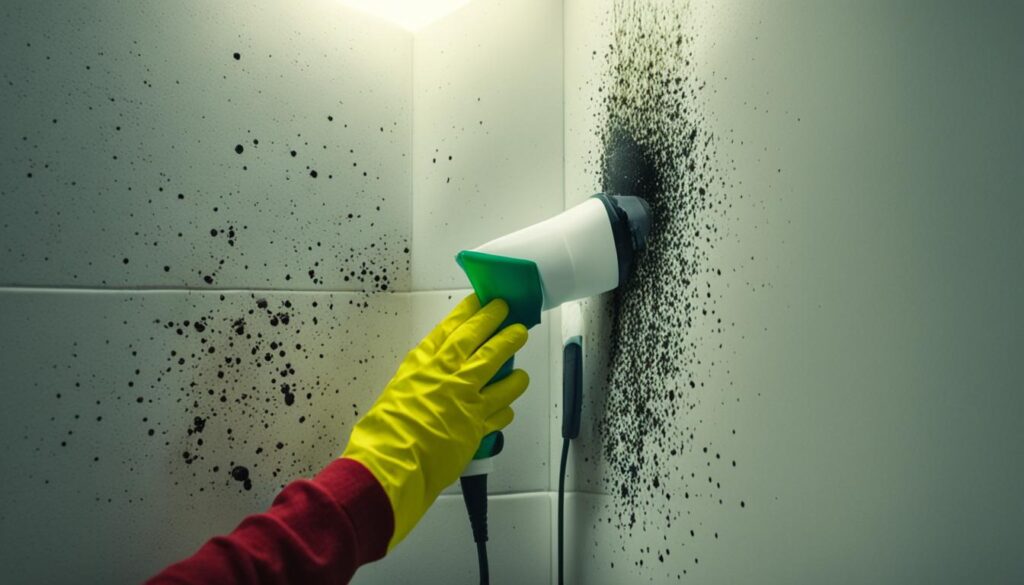
Effective Strategies to Get Rid Black Mold Safely
Black mold can be a serious problem in any home. Not only is it unsightly, but it can also have detrimental effects on your health and well-being. If you have discovered black mold in your home, it’s crucial to take immediate action to eliminate it safely and effectively.
In this section, we will discuss expert tips and strategies to help you get rid of black mold and create a healthy living environment for you and your family. By following these methods, you can ensure that your home is free from the dangers of black mold.
Key Takeaways:
- Black mold can pose serious health risks and should be addressed promptly.
- Proper assessment and identification of black mold are essential for effective remediation.
- Safe removal techniques, such as using protective gear and effective cleaning solutions, are crucial to prevent further contamination.
- Preventive measures, such as controlling humidity levels and addressing moisture issues, can help keep black mold away in the future.
- Seek professional assistance if needed to ensure a thorough mold assessment.
Understanding the Dangers of Black Mold
Before we dive into the strategies to get rid of black mold, it’s important to understand the potential dangers it poses. Black mold, scientifically known as Stachybotrys chartarum, is a type of toxic mold that can thrive in damp and humid environments. It tends to grow on materials high in cellulose, such as drywall, carpet, and wood.
Exposure to black mold can have serious health consequences. The spores released by black mold can trigger allergic reactions, respiratory issues, and even contribute to the development of asthma. Prolonged exposure to black mold can lead to more severe health problems, including sinusitis, bronchitis, and in rare cases, even neurotoxicity.

Research has linked black mold exposure to symptoms such as coughing, wheezing, sneezing, throat irritation, and itchy eyes. Individuals with compromised immune systems, such as the elderly, children, and those with respiratory conditions, are particularly vulnerable to the harmful effects of black mold.
Taking immediate action to remove black mold from your home is essential to protect your health and well-being. The next section will discuss effective strategies and techniques to safely and effectively get rid of black mold, ensuring a mold-free living environment for you and your loved ones.
Assessing and Identifying Black Mold
Properly assessing and identifying black mold is crucial for effective remediation. Black mold, scientifically known as Stachybotrys chartarum, can pose serious health risks if left untreated. In this section, we will provide guidance on how to assess and identify black mold in your home, including signs and symptoms to look out for.
Signs of Black Mold
Black mold can grow in areas with excessive moisture, such as bathrooms, basements, or areas affected by water damage. Pay attention to the following signs that may indicate black mold presence:
- Visible black or greenish-black patches on walls, ceilings, or other surfaces.
- A musty or earthy odor that persists even after cleaning or using air fresheners.
- Water stains or discoloration on walls or ceilings, indicating a possible water leak.
- Increase in allergy-like symptoms, such as sneezing, coughing, or respiratory irritation, when spending time in specific areas of your home.
If you notice any of these signs, it’s essential to take prompt action to assess and address the mold issue.
Identifying Black Mold
Although black mold is the commonly used term to describe Stachybotrys chartarum, it’s important to note that not all black molds are toxic. To accurately identify black mold, consider the following:
“Black color alone is not a reliable indicator of toxic mold. It’s important to seek professional assistance to correctly identify the mold species.”
To definitively identify the presence of black mold, it is recommended to consult a professional mold inspector or a certified indoor environmental professional. They have the expertise and necessary equipment to collect samples and conduct tests to determine the mold species and level of contamination.
Remember: If you suspect black mold in your home, it’s crucial to avoid touching or disturbing the mold and to limit your exposure to the affected area until proper assessment and remediation have taken place.

| Signs of Black Mold | Identifying Black Mold |
|---|---|
| Visible black or greenish-black patches on walls, ceilings, or other surfaces | Consult a professional mold inspector or a certified indoor environmental professional |
| A musty or earthy odor that persists even after cleaning or using air fresheners | Collect samples and conduct tests to determine the mold species and level of contamination |
| Water stains or discoloration on walls or ceilings, indicating a possible water leak | Avoid touching or disturbing the mold and limit exposure to the affected area |
| Increase in allergy-like symptoms, such as sneezing, coughing, or respiratory irritation |
Safe Removal Techniques for Black Mold
Once you have identified black mold in your home, it’s crucial to take immediate action to remove it safely and prevent further contamination. Proper removal techniques are essential to safeguard your health and ensure effective mold remediation.
Using Protective Gear
Before you begin the mold removal process, it is important to protect yourself from potential health risks associated with black mold exposure. Wear gloves, goggles, and a respirator mask to minimize your contact with mold spores and prevent inhalation. This protective gear creates a barrier between you and the mold, keeping you safe during the removal process.
Proper Ventilation
Good ventilation is key to preventing the spread of mold spores and maintaining a safe working environment. Open windows and use fans to increase airflow in the affected area. This helps to reduce moisture and improve air quality. Remember to seal off the contaminated area from the rest of your home to prevent cross-contamination.
Effective Cleaning Solutions
Choosing the right cleaning solution is vital for effective black mold removal. There are several options available, including commercial mold cleaners, vinegar, hydrogen peroxide, and bleach solutions. Research and select a cleaning solution that is safe and appropriate for the affected surface. Follow the manufacturer’s instructions and thoroughly clean all visible mold, ensuring you reach all crevices and corners.
Tip: When using bleach, ensure proper dilution and adequate ventilation. Never mix bleach with ammonia or any other cleaning agents, as it can produce toxic fumes.
After cleaning, thoroughly dry the area to discourage mold growth. Use dehumidifiers or fans to reduce humidity levels, as mold thrives in moist environments.
By employing these safe removal techniques, you can effectively eliminate black mold and restore a healthy living environment in your home.
Prevention Strategies to Keep Black Mold Away
Preventing the recurrence of black mold is essential for maintaining a mold-free home and ensuring the health and safety of your family. By implementing effective prevention strategies, you can keep black mold at bay and create a clean and healthy living environment. Here are some key measures to consider:
Controlling Humidity Levels
Black mold thrives in damp and humid environments, so it’s crucial to control the humidity levels in your home. Keep humidity below 50% by using dehumidifiers in areas prone to moisture, such as basements, bathrooms, and kitchens.
Addressing Moisture Issues
Moisture is the main culprit behind black mold growth. Regularly check for and repair any leaks in plumbing, roofs, or windows. Ensure proper ventilation in areas prone to moisture buildup, such as bathrooms and laundry rooms. Use exhaust fans or open windows to allow fresh air circulation.
Regular Maintenance and Cleaning
Regular maintenance and cleaning can help prevent the buildup of mold-inducing conditions. Keep your home clean and dry, especially in areas where moisture is common. Regularly inspect and clean air conditioning units, vents, and ducts to prevent moisture and mold growth.
Remember, prevention is key when it comes to black mold. By taking proactive measures to control humidity, address moisture issues, and maintain a clean living environment, you can keep black mold away and ensure the health and well-being of your family.
Implement these prevention strategies to create a mold-free home and enjoy a safe and healthy living environment.
Conclusion
Addressing black mold in your home requires a comprehensive approach that includes thorough assessment, safe removal, and proactive prevention strategies. By following the expert tips provided in this article, you can effectively get rid of black mold and maintain a healthy living environment for you and your loved ones.
Remember, the first step is to properly assess and identify black mold in your home. Look out for signs such as musty odors, discoloration on surfaces, and respiratory symptoms. Once identified, it’s crucial to remove black mold safely using protective gear, proper ventilation, and effective cleaning solutions.
Prevention is key in keeping black mold away for good. Control humidity levels by using dehumidifiers and ensuring proper ventilation in high-moisture areas. Address any moisture issues promptly, such as leaks or condensation, and perform regular maintenance to prevent the growth of mold.
If you’re unsure about the severity of black mold in your home or need professional assistance, reach out to Fix Mold Miami at 305-465-6653. Their experts can provide a thorough mold assessment and guide you through the process of safely eliminating black mold to create a healthier living space.




